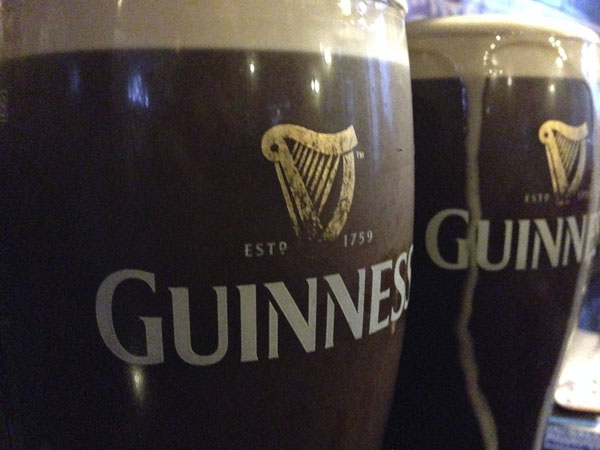When things go wrong and will not come right, Though you do the best you can, When life looks black as the hour of night – A pint of plain is your only man.
…. and so goes the first verse of Flann O’Brien’s (Brian O’Nolan) poem “The Workman’s Friend”[i]. A creamy pint of Guinness is not everyone’s favourite tipple, even in Dublin, but they say it does not travel well and maybe it is better here than anywhere else in the world because of the particular character of the local water. The average price of a pint of Guinness in Dublin is about €4.67 and weighs about 1.25 pounds without the glass. While savouring a pint of Guinness ensconced in a snug in a pub recently I was thinking that the price of a pint is a good measure of purchasing power and mark of inflation. In 1947 the price of a pint was just four cents[1].
The price of zinc is showing an incipient response to some kind of stimulus lately with the 60-day price of the Cinderella metal up almost 20 per cent from just over 90 cents to $1.07. The recent trajectory of the zinc price chart has a saw-tooth aspect to its rising trajectory and I expect this trend to be fractal over the longer term. As a voice crying in the wilderness for several years now I would like to think that this recent incipient price recovery has now substance supported by supply fundamentals which are factoring in the much widely touted mine-closures. Guinness works out at the equivalent of $4.22/lb so it is much more expensive that just a metal of finite supply disseminated in very small quantities within rocks commonly deep in the ground in remote parts of the globe.
Now for some alternative price benchmarking. The annual average US dollar per pound (lb) zinc price on the London Metal Exchange could be compared in a sug in a pub to the average annual price of a pint of Guinness in €uros over the last thirty years and there mught be an insight to be won and prompt me to order another pint as a reward. Hydrothermal alteration associated with the deposition of some mineral deposits is a helpful clue to the prospector. The particular kind of slight inebriation alteration taking place in the snug of a pub is enjoyable but I will avoid thepervasive and intense as the later retrograde alteration can result in a painful hangover.
Ignoring currency fluctuations for a minute, the average ratio between the price of a pint of Guinness and a pound of zinc over the last thirty years is 4.65 in a range between the deep soundings of 2002 when the zinc price fell to $778 (ratio was 8.4) and the dizzy heights of 2006 when the price soared to $3,265 (ratio of only 2.3). The current average price for a pint of plain in Dublin at around €4.67 indicates a zinc price-per-pound of $1.00 based on the thirty-year average ratio – bankers would call this the long-term average to which the price reverts to over time. From 1993 until 2005, with the exception of 1997, the zinc price was below the 30-year-average Guinness ratio and was then followed by a sharp price spike in 2006 and 2007 driven by speculators. Between 1985 and 1992 the zinc price was substantially below the 30-year average with a Guinness ratio of 1.83 as whefor example in 1988 when the price of a pint was €1.80 and zinc was 62 cents per pound reflecting a relatively high, real price for zinc. If world zinc mine supply is moving from seven years of plenty to seven years of famine then based on the current price of a pint of Guinness we could with a little imagination average a heady $2.55/lb for zinc over the coming years! Happy days but what do I know about metal price forecasting except what a good pint of Guiness should taste like. But what this does show is that at such a nominal price the real price of zinc benchmarked to the pint of plain is not unrealistic.
I am a director of a small Irish exploration company which recently acquired the exploration rights to the old Gortdrum copper-silver mine in County Tipperary. I came across the statutory prospectus for the listing of Gortdrum Mines Ltd dated September 30th, 1964. The prospectus was to raise $100,000 to delineate a mineable resource and thoroughly explore the property – $10,000 was set aside to run the company for a year. The exchange rate between the pound and the dollar at the time was two to five. The Capex for the new mine was $6 million dollars. Among the officers and directors of the Company were two remarkable mine finders, the Irishman and once Canadian emigrant Patrick Joseph Hughes is listed as a Mining Executive and Englishman Duncan Ramsey Derry wis listed as a Consulting Geologist. Pat Hughes and his compatriots McParland, Gilroy and McCarthy emigrated to Canada in the 1940’s to find work in construction. In their spare time they went prospecting up on the Canadian Shield and further west in Saskatchewan for uranium. The quartet formed Tara Exploration Limited at a bush camp while prospecting in Canada and Tara was incorporated in 1953. They returned to Ireland in 1955 the year that I was born to apply their prospecting skills to a land which at the time was commonly believed to be devoid of metal deposits of any consequence. Along the way they formed Northgate Exploration Ltd which discovered the Tynagh lead-zinc mine in 1961 and the first significant base-metal discovery in Ireland in more than a century. The Tara quartet went on to discover the world-class Tara (Navan) lead-zinc deposit just 45 kilometres northwest of Dublin in 1970. Many refer to Pat Hughes quite rightly as the father of modern Irish mining.
Dr D. R. Derry emigrated to Canada shortly after graduating in Honours Science from Cambridge in 1927. In 1935 he joined Mr Thayer Lindsley on a full-time basis at Ventures Ltd which later became Falconbridge. Dr Derry worked closely with Thayer Lindsley, the “unknown giant” of Canadian mining. Dr Derry’s work at Venture was interrupted by World War II when he enlisted and served as a squadron leader navigation training officer.
In 1950, he compiled a tectonic map of Canada with John Sinclair Stevenson. It was the first time in Canada that structural data from government, university, and industry sources were combined and synthesized. In 1954, Dr Derry became president of Rio Tinto Exploration.
Thayer Lindsley was a most unassuming but brilliant mine finder and carved out Canada’s biggest mining empire and went on to be equally successful internationally. At one time he controlled 21 companies listed on the Toronto Stock Exchange through his holding companies.
An exploration syndicate called the “Lower Limestone Syndicate” discovered the Gortdrum copper-silver deposit in 1963. The syndicate was formed by Dr Derry at the instigation of Thayer Lindsley for Westfield Minerals which was a stakeholder along with Northgate Exploration Ltd, Fort Reliance Minerals Ltd and Northfield Mines Inc. I suspect that Pat Hughes ran into Thayer Lindsley while prospecting for uranium in Saskatchewan but I have really no idea how these two chalk and cheese characters ended up collaborating on Gortdrum.
I was intrigued by the news that Catherine Raw is joining Barrick Gold’s “leadership” team as part of John Thornton’s push to improve the struggling company. Asset manager Catherine Raw was formerly co-head of Blackrock’s largest mining fund and as such a hunter of value. In 2013 the BlackRock Gold & General fund managed by Evy Hambro lost 48 percent. At Blackrock Ms Raw was co-manager of its $5 billion world mining fund and its smaller listed BlackRock World Mining Trust which also performed poorly in 2014. Mr Thornton said that Barrick needed to become “obsessed with talent” but what kind of talent I would ask? I would suggest that what Barrick needs is the help of experienced and talented geologists and mining engineers who can find mines, extract value and spot the fatal flaws. It is what you put into the financial model which is of paramount importance and not the ability to crunch numbers on a spread sheet. If chasing economies of scale at the expense of margin is at the kernel of Barrick’s problems why would you hire a CFA and fund manager, no matter how talented, to lead the way forward and decide what projects to invest in or mines to buy? Maybe it is a case of the hunter joing the hunted but what Barrick might need, and the international mining sector badly needs, is a modern version of a Chester Beatty or a Thayer Lindsley or indeed a Pat Hughes who all know the price of onions, and such knowledge I suggest is not found in books or spreadsheets and certainly not on a desktop.
[1] http://www.finfacts.ie/Private/bestprice/guinnessindex.htm
[i] http://www.maths.tcd.ie/~bradyn/flann.html


Nice piece John but the Guinness analogy has lost its appeal. The craft beer revolution has damaged fortress Guinness. Nowadays, measurements vis-à-vis Porterhouse Wrasslers or O’Hara’s stout are much more relevant. And this would be confirmed by Flann O’Brien if he were alive today. Modern-day Guinness is an awful long way away from the taste of the pint of plain referred to in “The Workman’s Friend”. Best of luck with Gortdrum.
Cheers Gerry,
It would be enjoyable to do the research; at least zinc is fungible in this regard.
Cheers
John
Well written as always. Not sure who will listen and let those talented geologists and engineers loose as there appears to be more fear of failure than the will to let perennial optimists (the exploration geologist) have a prolonged go at it.
Thanks Graham, I think as metal prices recover the pendulum will swing back and that greed will once again overcome fear
I wondered how long it would be before the great man appeared.
Not only did he praise Guinness, [porter maybe?], but he shot at every sacred cow that he could.
Precisely what any explorationist should do.
Enjoyed the article. Always good to have a bit of history.
Regards,
Chris.
Cheers Chris
you are one of the best exploration geos around.